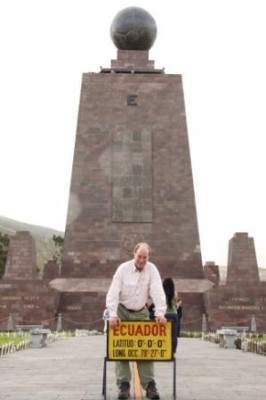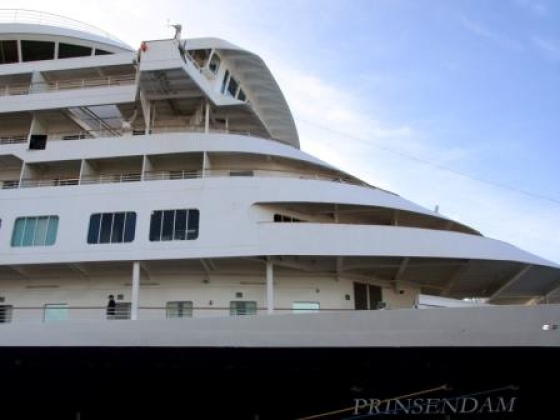We are now battling the northeasterly trade winds, plowing north to Panama, with Ecuador fading away in the South. It is an interesting place, Ecuador: the land, its people, the economy, the society, as well as the air traffic control.
 I mention the latter only because I had firsthand experience with it. Indeed, we flew from Manta, where we were docked, to Quito in the early morning; clockwork orange, in a brand new A319, with free snacks and coffee. The return flight was a different story though. Our flight was “in suspense” because the Control Tower in Manta had experienced catastrophic failure, whatever that may mean. Eventually, we were rerouted to the “old, small airport”. A 30-seat Dornier 328 propjet – my maiden flight – brought us back to the old and small airport just before scheduled sailing time.
I mention the latter only because I had firsthand experience with it. Indeed, we flew from Manta, where we were docked, to Quito in the early morning; clockwork orange, in a brand new A319, with free snacks and coffee. The return flight was a different story though. Our flight was “in suspense” because the Control Tower in Manta had experienced catastrophic failure, whatever that may mean. Eventually, we were rerouted to the “old, small airport”. A 30-seat Dornier 328 propjet – my maiden flight – brought us back to the old and small airport just before scheduled sailing time.
That was the surprising end to a surprising day, for Ecuador (at least the little that I have seen and heard from it) is a unique place in many respects. For one thing, the land has beauty to offer to anyone’s preference and likings: from coast and beaches, to mountains and valleys, plus a stretch of vibrant jungle, it is there for the picking. Some of that jungle is virtually unexplored or intentionally left alone, for the Huaroani and related tribes, while another part is the engine for the country as it produces the black gold.
The other important diversity concerns the people. Ecuador “sports” around thirty different ethnicities. They derive from African, Indian and Spanish origin, mixed in various ways. In certain regions there is still a large original indigenous population, which, in their own right, is quite diverse, identifiable by language, physical environment and traditions, owing to the many natural barriers all over the country. I was told that in the province of Chimborazo, for example, one ethnically homogenous group is spread over thirty villages across the mountains, while they dress ostensibly different from place to place and maintain small linguistic peculiarities.
Quito is, of course, a little bit of melting pot. The many beautiful women walking on the streets testify to that as well. As far as I can tell, this city has the highest density of female beauty in South America. (Other observers confirmed this conclusion regarding beautiful men). It is a rather unique place: three million people, on a 2400m (8000ft+) high alpine plain, enclosed by two cordilleras, with a nearby towering and active volcano measuring almost 6000m (18000ft). But that is not all, Quito also has taken care of its historical architectural heritage, which is a jewel (and UNESCO protected).
Centerpiece of these buildings is the plethora of churches. Every important order of monks or nuns has built a temple in Quito, from the sixteenth century onward. The most spectacular church, flanked nowadays by the neo-classical building that is the Central Bank, is the baroque Jesuit Cathedral. While I have visited all kinds of churches during my global wanderings, I have never seen such an expensively decorated interior as in this place: on walls, pillars, altars and roofs you see gold hanging, standing and shining. Artfully sculpted or just richly applied, the yellow metal is everywhere. If any adventurer ever wondered where the “Gold of the Amazon” was hidden, he should have started here! Of course, they also built schools, for indeed, their main business was education.
The currency of Ecuador is the US Dollar. Ten years ago that looked like a great move to stop the runaway hyperinflation. And even today it finds broad support; to quote our guide: it was the appropriate way to prevent politicians from printing money and to make sure that all Ecuadorians, and not just politicians, had dollar denominated, inflation-protected bank accounts. This strategy is comparable to what Greece opted for in Europe, except that they still did not manage their budget (and were hiding deficits, of course). Part of the reason why this has worked in Ecuador is … black gold. The latter may also explain why new politicians started to talk about reverting back to a “national currency”.
Oil was found in the Amazon basin about ten years ago. It enriched not only the state, it also brought prosperity to the country, and especially to the oil workers during the boom of 2006-8. As their bonus was linked to company profits many made ten times their yearly salary in bonus payments for a few years. That luck did not befall tuna fishermen and coca workers but, because of the additional income, which the state in party redistributed, Ecuadorians enjoy free healthcare, education (including university), unemployment benefits and … subsidized gas. The latter explains undoubtedly why one sees many cars and a lot of late model cars, as well as real traffic jams, a sight unseen since Buenos Aires.
 Of course, I also went to “La Mitad del Mundo”, the place at opposite ends of the continent from Macapà, in Brazil. Actually, it is here that (primarily) French scientist made the first exact scientific measurements about the earth’s equator. And, of course, I had my picture taken with one leg in the Northern and one in the Southern Hemisphere, simultaneously! The journey (journée) in Ecuador was a welcome reprieve from the choc of Peru: diversity and energy, both figuratively and literally. And there was lots of joy on the streets – Carnival is around the corner, as well!
Of course, I also went to “La Mitad del Mundo”, the place at opposite ends of the continent from Macapà, in Brazil. Actually, it is here that (primarily) French scientist made the first exact scientific measurements about the earth’s equator. And, of course, I had my picture taken with one leg in the Northern and one in the Southern Hemisphere, simultaneously! The journey (journée) in Ecuador was a welcome reprieve from the choc of Peru: diversity and energy, both figuratively and literally. And there was lots of joy on the streets – Carnival is around the corner, as well!
Prinsendam, Day 60 – Saturday March 5rd, 2011
Ready for tackling the Panama Canal!

